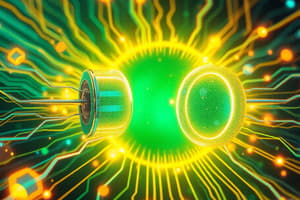Podcast
Questions and Answers
What is a PN junction in semiconductor physics?
What is a PN junction in semiconductor physics?
- A region with a high concentration of charge carriers
- A junction formed by a p-type and n-type semiconductor (correct)
- A region that lacks any atomic species
- A region where positive and negative electrons combine to form holes
What type of atomic species is added to create a p-type semiconductor?
What type of atomic species is added to create a p-type semiconductor?
- Atomic species with one extra electron
- Atomic species with no electrons
- Atomic species with two extra electrons
- Atomic species with one fewer electron (correct)
In a PN junction, what is the role of the depletion region?
In a PN junction, what is the role of the depletion region?
- It separates the P and N regions (correct)
- It creates an abundance of positive holes
- It has a high concentration of electrons
- It allows free flow of charge carriers
What causes the phenomenon of forward bias in a PN junction?
What causes the phenomenon of forward bias in a PN junction?
Which type of semiconductor has an excess of negative electrons?
Which type of semiconductor has an excess of negative electrons?
What allows current to flow more freely through a semiconductor in a forward bias?
What allows current to flow more freely through a semiconductor in a forward bias?
What happens to the flow of current in a semiconductor material when a reverse bias is applied across it?
What happens to the flow of current in a semiconductor material when a reverse bias is applied across it?
In n-type material, the net charge is negative due to:
In n-type material, the net charge is negative due to:
What does p-type doping introduce into a semiconductor material?
What does p-type doping introduce into a semiconductor material?
How do extrinsic semiconductors differ from intrinsic semiconductors in terms of energy levels?
How do extrinsic semiconductors differ from intrinsic semiconductors in terms of energy levels?
What determines the electrical conductivity of a semiconductor material?
What determines the electrical conductivity of a semiconductor material?
Which semiconductor device acts as both an electronic switch and an amplifier?
Which semiconductor device acts as both an electronic switch and an amplifier?
Flashcards are hidden until you start studying
Study Notes
Semiconductor Physics: Exploring PN Junctions, Doping, and Band Theory
In the realm of modern technology, semiconductor materials and devices are indispensable. This exploration of semiconductor physics will delve into the fundamental concepts of PN junctions, doping, and band theory, all of which are crucial to our understanding of semiconductors and their applications.
PN Junctions
A PN junction, the foundation of modern semiconductor devices, is formed by joining a p-type semiconductor and an n-type semiconductor. P-type material has a surplus of positive holes (absence of electrons) due to the addition of atomic species with one fewer electron (e.g., boron in silicon), while n-type material has an excess of negative electrons (donors) because of the addition of atomic species with one extra electron (e.g., phosphorus in silicon). The P and N regions are separated by a depletion region, where there are almost no free charge carriers (electrons or holes).
The PN junction exhibits interesting behavior due to its depletion region. A continuous flow of charge carriers occurs across the junction, which eliminates the electric field that normally exists in the depletion region. This phenomenon is known as forward bias, and it allows current to flow more freely through the semiconductor. Conversely, when a voltage is applied in the opposite direction (reverse bias), the electric field in the depletion region increases, which decreases the flow of current through the semiconductor.
Doping
Doping is the process of intentionally adding impurities to a semiconductor material to alter its electrical properties. The impurities can be electron donors (n-type doping) or electron acceptors (p-type doping). The net charge in n-type material is negative due to the excess of free electrons, while in p-type material, the net charge is positive due to the excess of holes. The concentration of dopant atoms determines the number of free charge carriers in the semiconductor material.
Band Theory
Within the context of semiconductor physics, band theory refers to the concept of energy levels in a semiconductor material. In intrinsic semiconductors, the valence band is filled with electrons, and the conduction band is empty. To create a flow of current, either electrons must jump to the conduction band (promotion) or holes must move (acceptance). In extrinsic semiconductors, doping introduces new energy levels in the bandgap, which increases the number of free charge carriers.
The bandgap of a semiconductor material is the energy difference between the conduction band and the valence band. It determines the material's electrical conductivity and its applicability in various electronic devices.
Semiconductor Devices
Semiconductors are the basis of a wide range of devices, from simple diodes to complex integrated circuits. PN junction diodes are the simplest semiconductor devices, enabling the control of current flow using forward or reverse bias. Transistors are another important semiconductor device, acting as electronic switches and amplifiers. The performance of semiconductor devices is influenced by material properties, such as bandgap and type of doping, which in turn depend on the semiconductor physics principles discussed earlier.
In conclusion, the concepts of PN junctions, doping, and band theory are fundamental to the understanding and development of semiconductor materials and devices. These principles have led to technological advancements in electronics, providing us with the miniaturization of electronic components and the continual expansion of computing power.
Studying That Suits You
Use AI to generate personalized quizzes and flashcards to suit your learning preferences.




